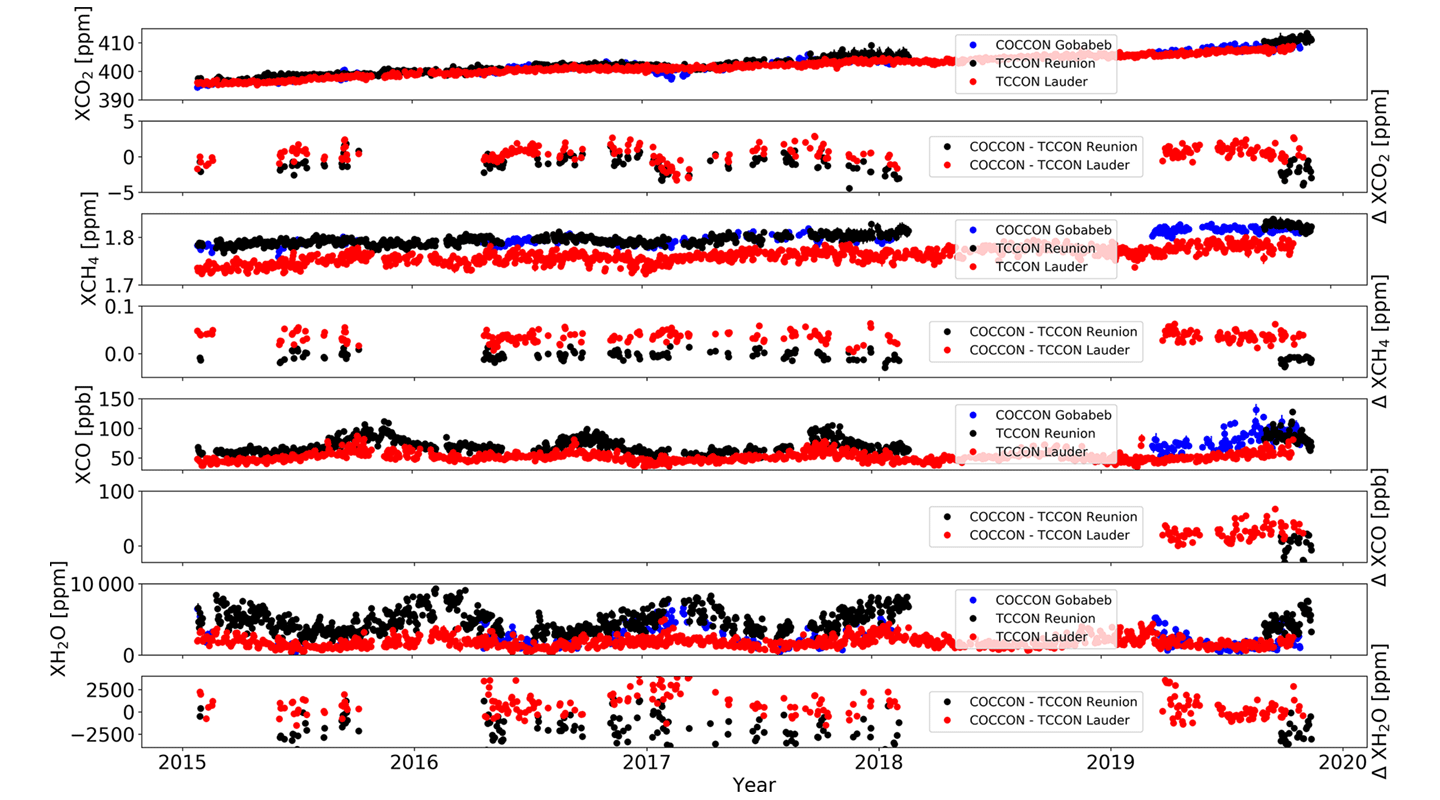Recent Research Results Long-term column-averaged greenhouse gas observations using a COCCON spectrometer at the high surface albedo site Gobabeb, Namibia
Precise and accurate observations of anthropogenic greenhouse gases (GHGs), especially carbon dioxide (CO2) and methane (CH4), are of utmost importance for long-term monitoring, and the estimation of their emission strengths and flux changes. However, like all measurements these need to be validated, particularly to avoid potential biases. The Total Carbon Column Observing Network (TCCON) performs ground-based observations of GHGs with reference precision using high-resolution Fourier Transform infrared (FTIR) spectrometers. For several satellites measuring GHGs TCCON data are the main validation source. Recently, in an effort to further improve the global coverage of ground-based FTIR spectrometers and complement TCCON in remote areas, the COllaborative Carbon Column Observing Network (COCCON) was established. This network utilizes the EM27/SUN FTIR spectrometer, a compact solar-viewing low-resolution instrument.
In this study, we present column-averaged dry-air mole fractions of CO2 (XCO2), CH4 (XCH4) and carbon monoxide (XCO) from a recently established measurement site in Gobabeb, Namibia (Fig. 1). Gobabeb is a hyperarid desert site at the sharp transition zone between the sand desert and the gravel plains, offering unique characteristics with respect to surface albedo properties. Measurements started in January 2015 and are performed utilizing a spectrometer of the COCCON network. Gobabeb is the first measurement site observing XCO2, XCH4 and XCO on the African mainland and improves the global coverage of ground-based remote-sensing sites.

In order to achieve the high level of precision and accuracy necessary for meaningful greenhouse gas observations, we performed calibration measurements for eight days between November 2015 and March 2016 with the COCCON reference EM27/SUN spectrometer (operated) at the Karlsruhe Institute of Technology. We derived scaling factors for XCO2, XCH4 and XCO with respect to the reference instrument that are close to 1.0.
We compare the results obtained in Gobabeb to measurements from the TCCON sites at Reunion Island and Lauder (Fig. 2). We choose these TCCON sites because, while 4000 km apart, the instruments at Gobabeb and Reunion Island operate at roughly the same latitude. The Lauder station is the southernmost TCCON station and functions as a background site without a pronounced XCO2 seasonal cycle. Apart from an expected XCH4 offset between Gobabeb and Lauder due to significantly different tropopause height, we find a good agreement for the absolute Xgas values, as well as representative intraday variability between TCCON and COCCON. Together with the absence of long-term drifts, this highlights the high quality of the COCCON measurements. In the Southern hemispheric summer, we observe lower XCO2 values at Gobabeb compared to the TCCON stations, likely due to the influence of the African biosphere.

We performed coincident measurements with the Greenhouse Gases Observing Satellite (GOSAT), where GOSAT observed three nearby specific observation points, over the sand desert south of the station, directly over Gobabeb and over the gravel plains to the north (Fig. 1). GOSAT H-gain XCO2 and XCH4 agree with the EM27/SUN measurements within the 1 σ uncertainty limit (Fig. 3). The number of coincident soundings is limited, but we confirm a bias of 1.2 - 2.6 ppm between GOSAT M-gain and H-gain XCO2 retrievals depending on the target point. This agrees with results reported by a previous study and the GOSAT validation team. We also report a bias of 5.9 - 9.8 ppb between GOSAT M-gain and H-gain XCH4 measurements which is within the range given by the GOSAT validation team.

Finally, we use the COCCON measurements to evaluate inversion-optimized CAMS model data. For XCO2 we find high biases of 0.9 ± 0.5 ppm for the OCO-2 assimilated product and 1.1 ± 0.6 ppm for the in situ-driven product with R2 > 0.9 in both cases. These biases are comparable to reported offsets between the model and TCCON data. The OCO-2 assimilated model product can reproduce the drawdown of XCO2 observed by the COCCON instrument at the beginning of 2017, as opposed to the in situ-optimized product. Also, for XCH4, the observed biases are in line with prior model comparisons with TCCON.
In a future study, we plan to extend this study and use multiple stations from the COCCON network for satellite and model validation. The COCCON instruments are stationed in Finland, Germany, Greece, Japan, Namibia, Sweden and the USA. They span a range of different atmospheric and observing conditions, from subtropical to subpolar regions, including boreal forests and deserts, low and high albedo surfaces, polluted and clean areas.

